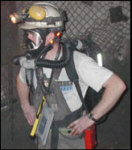Miners are often exposed to toxic substances on the job. Lack of awareness of such materials is the frequent cause of many mishaps. Workers need to be told the names of substances with which they are working, if there are any potential health hazards, and what control measures are available. This should include receiving general information about how chemicals enter and affect the body. The work in this topic area is supported by the NIOSH Mining Chemical Hazards program. See the NIOSH Mining Products page for software, guides, training materials or other items related to this topic. |
|
Hazardous Materials Management Spotlights
HazComWriter |
Software
Technology News 524 - HazComWriter Compliance Tool for MSHA Rule 30 CFR Part 47 or OSHA Rule 29 CFR 1910.1200 (PDF, 640 KB, 2007-06)
NIOSH developed the HazComWriter to replace the HazCom Helper-MSHA version (NIOSH Publication 2003-118) and the HazCom Helper-OSHA version (NIOSH Publication 2005-135). The HazComWriter is designed to help companies write their required HazCom plan and list all hazardous chemicals at a company's site by leading the person responsible for writing the HazCom plan step-by-step through its preparation.
HazComWriter
Based in part on customer input, NIOSH combined the MSHA and OSHA versions of the HazCom Helper into one easy-to-use tool. This tool, the HazComWriter, is more robust than its predecessors and features a new sort utility, storage of the chemical list in an Excel format, and easy to use menus. The document produced by the HazComWriter software will satisfy both MSHA and OSHA requirements for a "written hazardous communication document."
Hazards
Development of a Field Method for Measuring Manganese in Welding Fume (PDF, 111 KB, 2007-11)
This paper describes a study in which a field colorimetric method for extracting and measuring manganese in welding fume was developed.
Measurement & analysis
Selected Health Issues in Mining (PDF, 398 KB, 2003-02)
This paper briefly discusses the current status of some miner health-related issues, including those involving coal dust, silica dust, diesel particulate matter, asbestos, noise, lead, welding fumes, and skin disorders, as well as research and other activities aimed at protecting miners from occupational illnesses and disease.
Tasks & activities
Tame the Flame: Flame Cutting and Welding Safety for Underground Coal Miners: 2008 Safety Tip Calendar (PDF, 2377 KB, 2007-12)
A 2008 Calendar for underground coal miners that gives different flame cutting and welding tips each month.
Information gateways
Chemical Safety
NIOSH page on chemical safety.
NIOSH Pocket Guide to Chemical Hazards
The NIOSH Pocket Guide to Chemical Hazards (NPG) is intended as a source of general industrial hygiene information on several hundred chemicals/classes for workers, employers, and occupational health professionals. The NPG does not contain an analysis of all pertinent data, rather it presents key information and data in abbreviated or tabular form for chemicals or substance groupings (e.g. cyanides, fluorides, manganese compounds) that are found in the work environment. The information found in the NPG should help users recognize and control occupational chemical hazards.
 A hazardous material is any material (biological, chemical, physical) which has the potential to cause harm to humans, animals, or the environment. CFR 1910.1200 defines hazardous materials as any substance or chemical which is a health hazard or physical hazard, including chemicals which are carcinogens, toxic agents, irritants, corrosive, sensitizers; agents which damage the lungs, skin, eyes, or mucous membranes; chemicals which are combustible, explosive, flammable, oxidizers; and chemicals which in the course of normal handling, use, or storage may produce toxic dusts, gases, fumes, vapors, mists, or smoke.
A hazardous material is any material (biological, chemical, physical) which has the potential to cause harm to humans, animals, or the environment. CFR 1910.1200 defines hazardous materials as any substance or chemical which is a health hazard or physical hazard, including chemicals which are carcinogens, toxic agents, irritants, corrosive, sensitizers; agents which damage the lungs, skin, eyes, or mucous membranes; chemicals which are combustible, explosive, flammable, oxidizers; and chemicals which in the course of normal handling, use, or storage may produce toxic dusts, gases, fumes, vapors, mists, or smoke.